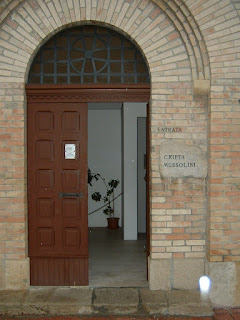Milan rally in 1919 launched the National Fascist Party
 |
| Benito Mussolini pictured in around 1914 |
A war veteran and former socialist activist who had moved towards a more nationalist political stance, Mussolini initially drew his followers together as the Fasci Italiani di Combattimento (Italian Combat Group).
This group evolved into the Partito Nazionale Fascista (PNF) two years later, sweeping to power in 1922 when King Victor Emmanuel III, fearing civil war after 30,000 of Mussolini's supporters, the Blackshirts, marched on Rome, asked Mussolini to form a government.
Born the son of a blacksmith in Predappio, in Emilia-Romagna, Mussolini had been an active socialist, first in Switzerland, where he had moved as a 19-year-old to seek work and avoid military service, and again when he returned to Italy. He became a leading figure in the Italian Socialist Party (PSI) and edited the left-wing newspaper Avanti.
But he was expelled by the PSI because of his opposition to the party's neutral stance on the First World War, in which he saw intervention as an opportunity to further the revolutionary aims of the left, particularly by overthrowing the Habsburg monarchies in Germany and Austria-Hungary.
He began to lose faith in orthodox socialism, believing that national identity had become more important than class struggle in forging the kind of society that was central to his vision, one in which the removal of class divides was still key but which also recognised culture, tradition, language and race.
Italy in the early 20th century was a unified country but still a long way from unity in political terms, with an appetite for revolution still rife, particularly among those who disagreed with the monarchy. Different groups went under the name of fasci, the plural form of the word fascio, meaning bundle or sheaf, that had become a symbol of strength through unity.
After his shift away from conventional socialism, Mussolini became prominent in the Fasci d'Azione Rivoluzionaria - Revolutionary Action Group -- whose followers were the first to refer to themselves as Fascisti (Fascists).
Mussolini's political activity was curtailed when he signed up for the Italian Army but resumed on his return following wounds suffered when a mortar bomb accidentally exploded in a trench. He relaunched FAR as Fasci Italiani di Combattimento -- Italian Combat Group -- attracting support among war veterans and a variety of malcontents at the Milan rally in 1919, which he had promoted via his new newspaper, Il Popolo d'Italia.
The group began with around 200 members and grew rapidly, Mussolini promoting a vision of Italy as a global power on a level with its Roman past while at the same time being a nation without social divisions. They encountered violent opposition from communists, socialists and anarchists but Mussolini's attitude was to meet force with force. Soon, squads of his followers, armed and wearing the black shirts that had become their uniform, began patrolling the streets to keep order.
 |
| Piazza San Sepolcro in Milan, looking across to the church of the same name |
Travel tip:
The Piazza San Sepolcro, where Mussolini staged the 1919 rally that led to the formation of his Fasci Italiani di Combattimento, is situated in central Milan, not far from the Duomo and immediately adjacent to the Biblioteca Ambrosiana, which houses thousands of historic manuscripts and dates back to 1609. The Ambrosiana's Sala Fredericiana reading room was open to the public at that time, which makes it the second oldest public library in Europe, after the Bodleian at Oxford.
 |
| The entrance to the Mussolini mausoleum in Predappio |
Predappio, where Mussolini was born in 1883, is a small town in Emilia-Romagna situated around 18 kilometres south of Forli. The former dictator was buried in a family mausoleum in a cemetery just outside the town, which has become a tourist attraction, albeit a somewhat macabre one. Controversially, Predappio has also been adopted as a pilgrimage site for neofascists, with some shops openly selling neofascist memorabilia.
Home